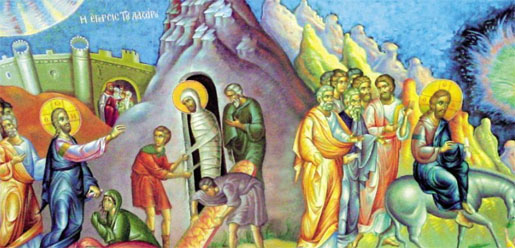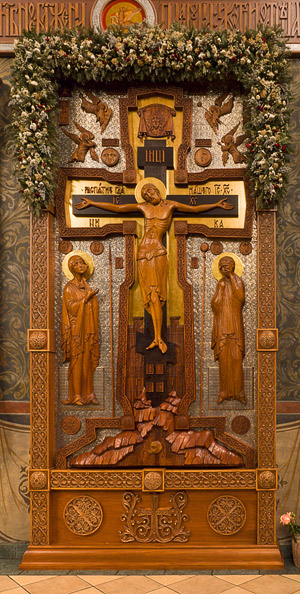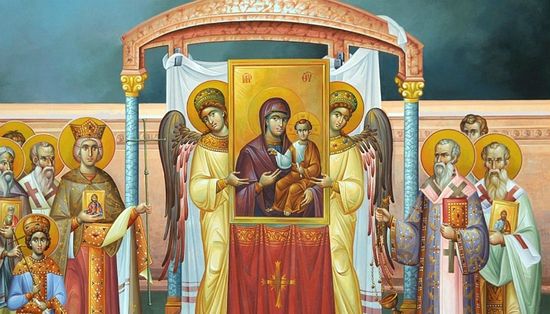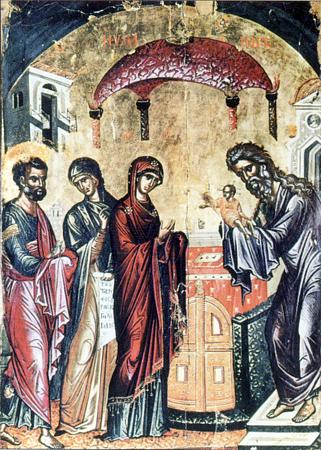Calendar
Sermon by Hieromonk Methodius (Yogel) on Palm Sunday
5. April 2015 - 17:10 He Who Comes in the Name of the Lord
He Who Comes in the Name of the Lord
Fear not, daughter of Sion: behold, thy King cometh, sitting on an ass’s colt.
Jerusalem is abuzz… Jerusalem trembles with joyous excitement… So close is the dawn of her rising up, her resurrection in the brilliance of her former glory.
The righteous soul of the Jews suffered under the yoke of the heathen rule of Rome. O, Lord, how much longer? That was the hope, the fervent desire of the disobedient, rebellious seed of the Patriarch Abraham, who found the path to heavenly and earthly glory through his own obedience.
Synaxarion for Lazarus Saturday
4. April 2015 - 10:04 On this day, the Saturday before Palm Sunday, we celebrate the fourth-day raising from the dead of Lazarus, the righteous friend of Christ.
On this day, the Saturday before Palm Sunday, we celebrate the fourth-day raising from the dead of Lazarus, the righteous friend of Christ.
Lazarus[1] was a Hebrew, of the sect of the Pharisees and, as far as is known, he was the son of Simon the Pharisee, who dwelt in the village of Bethany. He became a friend of our Lord Jesus Christ when He sojourned on earth for the salvation of our race. For when Christ continually conversed with Simon, entering his house and discoursing on the resurrection from the dead, Lazarus was quite pleased with the genuineness of this teaching, and not only he, but also his two sisters, Martha and Mary.
Homily on the Sunday of the Veneration of the Cross
15. March 2015 - 13:31 In the Name of the Father, and of the Son, and of the Holy Spirit!
In the Name of the Father, and of the Son, and of the Holy Spirit!
The attitude in the Church of God towards the Lord’s Cross sometimes seems unusual and surprising to the world. And since we are in many ways sensual rather than spiritual, we too sometimes share this perplexity with the world. For example, why has the Cross been treated as a special, incomprehensible, but real living power in the Church’s Tradition for two thousand years already? Even now, during Great Lent, we daily pray the following during the divine services: “O Invincible and incomprehensible and divine power of the precious and life-giving Cross, forsake not us sinners.”
Moreover, the Church boldly asserts such astounding truths as these: “The Cross is the guardian of the whole world; the Cross is the beauty of the Church, the Cross is the might of kings; the Cross is the confirmation of the faithful, the Cross is the glory of angels and the wounding of demons.”
The Triumph of Jesus Christ in the Triumph of Orthodoxy
1. March 2015 - 2:41 The first Sunday of Great Lent is celebrated as the Triumph of Orthodoxy. This is connected with the victory of the iconodules (those who supported the veneration of sacred images) over the iconoclasts (those who opposed their veneration).
The first Sunday of Great Lent is celebrated as the Triumph of Orthodoxy. This is connected with the victory of the iconodules (those who supported the veneration of sacred images) over the iconoclasts (those who opposed their veneration).
The heart of the victory of Orthodoxy in the restoration of iconography—as well as our veneration of the same—is found in the incarnation of Jesus Christ. Christology is the beginning and end of all true theology, and whenever we get Christ wrong, we get everything else wrong.
Venerable Simeon the Myrrhgusher and Prince of Serbia - Stephen Nemanya
22. February 2015 - 14:27
Saint Simeon the Myrrh-Gusher, King of Serbia Stephen Nemanya was the Great Zhupan of Serbia, and lived during the twelfth century. The saint toiled much for his fatherland: he united a large portion of the Serbian lands, and strove for the political independence of his country from the Byzantine Empire. In his zeal for the Orthodox Church, he defended his nation against heresy and false teaching.
At the age of eighty, Stephen went to Mt. Athos, where his son St Sava (January 12), was glorified by the holiness of his life. Together they restored the desolate Hilandar monastery, to which monks from various lands began to gather.
St Simeon was a great ascetic and wise guide for the monks. He died on February 13, 1200, and his relics began to exude myrrh. St Sava transported his father’s relics back to Serbia, and placed them in a church of the Most Holy Theotokos at the River Studenitsa. St Simeon had richly adorned this church while he was still ruler of Serbia.
The Meeting of the Lord
15. February 2015 - 13:48 According to the Law of Moses, all Hebrew parents must bring their first born son on the fortieth day after birth to the Temple to be consecrated to God. It was the custom to bring a sacrifice in thanksgiving to God. The law was established in remembrance of the exodus of the Hebrews from Egypt — freedom from slavery — when the first-born Hebrews were spared from death.
According to the Law of Moses, all Hebrew parents must bring their first born son on the fortieth day after birth to the Temple to be consecrated to God. It was the custom to bring a sacrifice in thanksgiving to God. The law was established in remembrance of the exodus of the Hebrews from Egypt — freedom from slavery — when the first-born Hebrews were spared from death.
In fulfilment of this law, the Mother of God with Joseph brought the infant Jesus to the Temple in Jerusalem and brought for the sacrifice two fledgling doves.
At this time in Jerusalem, there lived an old man by the name of Simeon. He was a righteous, pious man, and he awaited the coming of the Messiah. It was foretold to him by the Holy Spirit that he would not have died before he had seen Christ the Lord. Simeon waited for the fulfilment of the promise of God for a long time. According to tradition, he lived about 300 years. Then, one day, by the inspiration of the Holy Spirit, he went to the Temple. When Mary with Joseph brought the infant Jesus, Simeon met the Child, took Him in his arms, and glorifying God said, "Now lettest Thou Thy servant depart in peace, O Master, according to Thy word, for mine eyes have seen Thy salvation, which Thou hast prepared before the face of all peoples, a light of revelation for the Gentiles, and the glory of Thy people Israel."

